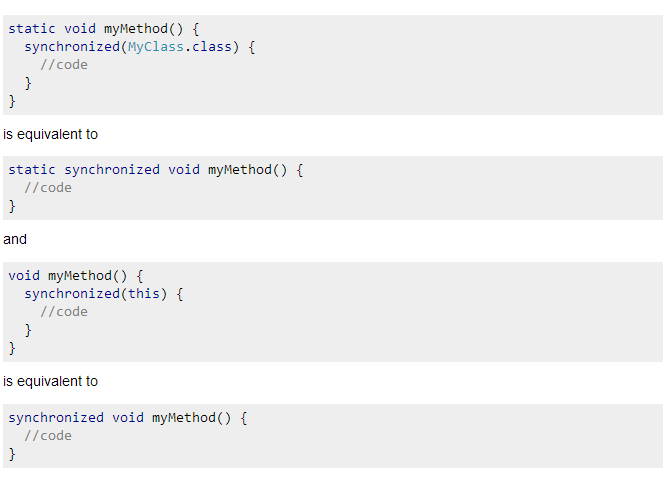Java synchronized 详解
下面的文字均来自其它博客和网页。
参考:http://www.jianshu.com/p/ea9a482ece5f
由于同一进程的多个线程共享同一片存储空间,在带来方便的同时,也带来了访问冲突这个严重的问题。Java语言提供了专门机制以解决这种冲突,有效避免了同一个数据对象被多个线程同时访问。
需要明确的几个问题:
- synchronized关键字可以作为函数的修饰符,也可作为函数内的语句,也就是平时说的同步方法和同步语句块。如果 再细的分类,synchronized可作用于instance变量、object reference(对象引用)、static函数和class literals(类名称字面常量)身上。
- 无论synchronized关键字加在方法上还是对象上,它取得的锁都是对象,而不是把一段代码或函数当作锁――而且同步方法很可能还会被其他线程的对象访问。
- 每个对象只有一个锁(lock)与之相关联。
- 实现同步是要很大的系统开销作为代价的,甚至可能造成死锁,所以尽量避免无谓的同步控制。
synchronized关键字的作用域有二种:
- 某个对象实例内,synchronized aMethod(){}可以防止多个线程同时访问这个对象的synchronized方法(如果一个对象有多个synchronized方法,只要一个线 程访问了其中的一个synchronized方法,其它线程不能同时访问这个对象中任何一个synchronized方法)。这时,不同的对象实例的 synchronized方法是不相干扰的。也就是说,其它线程照样可以同时访问相同类的另一个对象实例中的synchronized方法;
- 某个类的范围,synchronized static aStaticMethod{}防止多个线程同时访问这个类中的synchronized static 方法。它可以对类的所有对象实例起作用。

synchronized 方法
每个类实例对应一把锁,每个 synchronized 方法都必须获得调用该方法的类实例的锁方能执行,否则所属线程阻塞,方法一旦执行,就独占该锁,直到从该方法返回时才将锁释放,此后被阻塞的线程方能获得该锁,重新进入可执行状态。这种机制确保了同一时刻对于每一个类实例,其所有声明为 synchronized 的成员函数中至多只有一个处于可执行状态(因为至多只有一个能够获得该类实例对应的锁),从而有效避免了类成员变量的访问冲突(只要所有可能访问类成员变量的方法均被声明为 synchronized)。
在 Java 中,不光是类实例,每一个类也对应一把锁,这样我们也可将类的静态成员函数声明为 synchronized ,以控制其对类的静态成员变量的访问。
synchronized 方法的缺陷
同步方法,这时synchronized锁定的是哪个对象呢?它锁定的是调用这个同步方法对象。也就是说,当一个对象 P1在不同的线程中执行这个同步方法时,它们之间会形成互斥,达到同步的效果。但是这个对象所属的Class所产生的另一对象P2却可以任意调用这个被加 了synchronized关键字的方法.同步方法实质是将synchronized作用于object reference。――那个拿到了P1对象锁的线程,才可以调用P1的同步方法,而对P2而言,P1这个锁与它毫不相干,程序也可能在这种情形下摆脱同步机制的控制,造成数据混乱:(
;若将一个大的方法声明为synchronized 将会大大影响效率,典型地,若将线程类的方法 run() 声明为 synchronized ,由于在线程的整个生命期内它一直在运行,因此将导致它对本类任何 synchronized 方法的调用都永远不会成功。当然我们可以通过将访问类成员变量的代码放到专门的方法中,将其声明为 synchronized ,并在主方法中调用来解决这一问题,但是 Java 为我们提供了更好的解决办法,那就是 synchronized 块。
synchronized 代码块
除了方法前用synchronized关键字,synchronized关键字还可以用于方法中的某个区块中,表示只对这个区块的资源实行互斥访问。用法是: synchronized(this){/区块/},它的作用域是当前对象。
这时锁就是对象,谁拿到这个锁谁就可以运行它所控制的那段代码。当有一个明确的对象作为锁时,就可以这样写程序,但当没有明确的对象作为锁,只是想让一段代码同步时,可以创建一个特殊的instance变量(它得是一个对象)来充当锁:
class Foo implements Runnable {
private byte[] lock = new byte[0]; // 特殊的instance变量
Public void methodA() {
synchronized(lock) { //… }
}
//…..
}注:零长度的byte数组对象创建起来将比任何对象都经济――查看编译后的字节码:生成零长度的byte[]对象只需3条操作码,而Object lock = new Object()则需要7行操作码。
synchronized 静态方法
将synchronized作用于static 函数,示例代码如下:
Class Foo {
// 同步的static 函数
public synchronized static void methodAAA() {
//….
}
public void methodBBB() {
synchronized(Foo.class) // class literal(类名称字面常量)
}
}代码中的methodBBB()方法是把class literal作为锁的情况,它和同步的static函数产生的效果是一样的,取得的锁很特别,是当前调用这个方法的对象所属的类(Class,而不再是由这个Class产生的某个具体对象了)。
可以推断:如果一个类中定义了一个synchronized 的 static 函数A,也定义了一个 synchronized 的 instance函数B,那么这个类的同一对象Obj在多线程中分别访问A和B两个方法时,不会构成同步,因为它们的锁都不一样。B方法的锁是Obj这个对象,而B的锁是Obj所属的那个Class。
原文链接:http://www.jianshu.com/p/ea9a482ece5f
著作权归作者所有,转载请联系作者获得授权,并标注“简书作者”。
下面是另一篇博客,写得也不错。
来自: http://zhangjunhd.blog.51cto.com/113473/70300/
在并发环境下,解决共享资源冲突问题时,可以考虑使用锁机制。
|
package com.zj.lock;
import java.util.concurrent.TimeUnit;
public class Resource1 {
public void f() {
// other operations should not be locked...
System.out.println(Thread.currentThread().getName()
+ ":not synchronized in f()");
synchronized (this) {
for (int i = 0; i < 5; i++) {
System.out.println(Thread.currentThread().getName()
+ ":synchronized in f()");
try {
TimeUnit.SECONDS.sleep(3);
} catch (InterruptedException e) {
e.printStackTrace();
}
}
}
}
public void g() {
// other operations should not be locked...
System.out.println(Thread.currentThread().getName()
+ ":not synchronized in g()");
synchronized (this) {
for (int i = 0; i < 5; i++) {
System.out.println(Thread.currentThread().getName()
+ ":synchronized in g()");
try {
TimeUnit.SECONDS.sleep(3);
} catch (InterruptedException e) {
e.printStackTrace();
}
}
}
}
public void h() {
// other operations should not be locked...
System.out.println(Thread.currentThread().getName()
+ ":not synchronized in h()");
synchronized (this) {
for (int i = 0; i < 5; i++) {
System.out.println(Thread.currentThread().getName()
+ ":synchronized in h()");
try {
TimeUnit.SECONDS.sleep(3);
} catch (InterruptedException e) {
e.printStackTrace();
}
}
}
}
public static void main(String[] args) {
final Resource1 rs = new Resource1();
new Thread() {
public void run() {
rs.f();
}
}.start();
new Thread() {
public void run() {
rs.g();
}
}.start();
rs.h();
}
}
|
|
package com.zj.lock;
import java.util.concurrent.TimeUnit;
public class Resource2 {
private Object syncObject1 = new Object();
private Object syncObject2 = new Object();
public void f() {
// other operations should not be locked...
System.out.println(Thread.currentThread().getName()
+ ":not synchronized in f()");
synchronized (this) {
for (int i = 0; i < 5; i++) {
System.out.println(Thread.currentThread().getName()
+ ":synchronized in f()");
try {
TimeUnit.SECONDS.sleep(3);
} catch (InterruptedException e) {
e.printStackTrace();
}
}
}
}
public void g() {
// other operations should not be locked...
System.out.println(Thread.currentThread().getName()
+ ":not synchronized in g()");
synchronized (syncObject1) {
for (int i = 0; i < 5; i++) {
System.out.println(Thread.currentThread().getName()
+ ":synchronized in g()");
try {
TimeUnit.SECONDS.sleep(3);
} catch (InterruptedException e) {
e.printStackTrace();
}
}
}
}
public void h() {
// other operations should not be locked...
System.out.println(Thread.currentThread().getName()
+ ":not synchronized in h()");
synchronized (syncObject2) {
for (int i = 0; i < 5; i++) {
System.out.println(Thread.currentThread().getName()
+ ":synchronized in h()");
try {
TimeUnit.SECONDS.sleep(3);
} catch (InterruptedException e) {
e.printStackTrace();
}
}
}
}
public static void main(String[] args) {
final Resource2 rs = new Resource2();
new Thread() {
public void run() {
rs.f();
}
}.start();
new Thread() {
public void run() {
rs.g();
}
}.start();
rs.h();
}
}
|
|
package com.zj.lock;
import java.util.concurrent.TimeUnit;
import java.util.concurrent.locks.Lock;
import java.util.concurrent.locks.ReentrantLock;
public class Resource3 {
private Lock lock = new ReentrantLock();
public void f() {
// other operations should not be locked...
System.out.println(Thread.currentThread().getName()
+ ":not synchronized in f()");
lock.lock();
try {
for (int i = 0; i < 5; i++) {
System.out.println(Thread.currentThread().getName()
+ ":synchronized in f()");
try {
TimeUnit.SECONDS.sleep(3);
} catch (InterruptedException e) {
e.printStackTrace();
}
}
} finally {
lock.unlock();
}
}
public void g() {
// other operations should not be locked...
System.out.println(Thread.currentThread().getName()
+ ":not synchronized in g()");
lock.lock();
try {
for (int i = 0; i < 5; i++) {
System.out.println(Thread.currentThread().getName()
+ ":synchronized in g()");
try {
TimeUnit.SECONDS.sleep(3);
} catch (InterruptedException e) {
e.printStackTrace();
}
}
} finally {
lock.unlock();
}
}
public void h() {
// other operations should not be locked...
System.out.println(Thread.currentThread().getName()
+ ":not synchronized in h()");
lock.lock();
try {
for (int i = 0; i < 5; i++) {
System.out.println(Thread.currentThread().getName()
+ ":synchronized in h()");
try {
TimeUnit.SECONDS.sleep(3);
} catch (InterruptedException e) {
e.printStackTrace();
}
}
} finally {
lock.unlock();
}
}
public static void main(String[] args) {
final Resource3 rs = new Resource3();
new Thread() {
public void run() {
rs.f();
}
}.start();
new Thread() {
public void run() {
rs.g();
}
}.start();
rs.h();
}
}
|
|
package com.zj.lock;
import java.util.concurrent.TimeUnit;
import java.util.concurrent.locks.Lock;
import java.util.concurrent.locks.ReentrantLock;
public class Resource4 {
private Lock lock1 = new ReentrantLock();
private Lock lock2 = new ReentrantLock();
private Lock lock3 = new ReentrantLock();
public void f() {
// other operations should not be locked...
System.out.println(Thread.currentThread().getName()
+ ":not synchronized in f()");
lock1.lock();
try {
for (int i = 0; i < 5; i++) {
System.out.println(Thread.currentThread().getName()
+ ":synchronized in f()");
try {
TimeUnit.SECONDS.sleep(3);
} catch (InterruptedException e) {
e.printStackTrace();
}
}
} finally {
lock1.unlock();
}
}
public void g() {
// other operations should not be locked...
System.out.println(Thread.currentThread().getName()
+ ":not synchronized in g()");
lock2.lock();
try {
for (int i = 0; i < 5; i++) {
System.out.println(Thread.currentThread().getName()
+ ":synchronized in g()");
try {
TimeUnit.SECONDS.sleep(3);
} catch (InterruptedException e) {
e.printStackTrace();
}
}
} finally {
lock2.unlock();
}
}
public void h() {
// other operations should not be locked...
System.out.println(Thread.currentThread().getName()
+ ":not synchronized in h()");
lock3.lock();
try {
for (int i = 0; i < 5; i++) {
System.out.println(Thread.currentThread().getName()
+ ":synchronized in h()");
try {
TimeUnit.SECONDS.sleep(3);
} catch (InterruptedException e) {
e.printStackTrace();
}
}
} finally {
lock3.unlock();
}
}
public static void main(String[] args) {
final Resource4 rs = new Resource4();
new Thread() {
public void run() {
rs.f();
}
}.start();
new Thread() {
public void run() {
rs.g();
}
}.start();
rs.h();
}
}
|



【推荐】国内首个AI IDE,深度理解中文开发场景,立即下载体验Trae
【推荐】编程新体验,更懂你的AI,立即体验豆包MarsCode编程助手
【推荐】抖音旗下AI助手豆包,你的智能百科全书,全免费不限次数
【推荐】轻量又高性能的 SSH 工具 IShell:AI 加持,快人一步